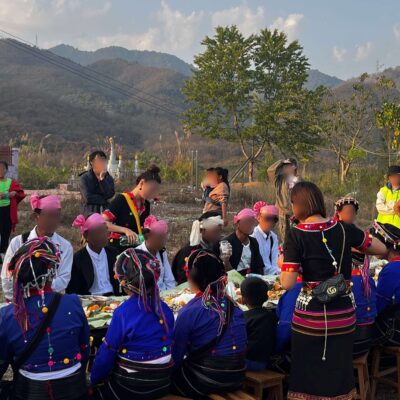In the past few decades, the flow of Chinese students to overseas universities has made Chinese international students (CISs) a global phenomenon. Their presence in the global educational sphere has drawn significant attention from both mainstream media and academic researchers. However, this attention often reduces CISs to a simplistic, homogeneous “issue” that needs to be addressed.
This article examines the typical representations of CISs stigmatised in Australia’s mainstream media and academic discourse. Based on the analysis, we argue that these typical representations are rooted in an outdated frame of methodological nationalism, maintained largely by an understanding of China and CISs as being a fundamentally different other, without paying attention to the deep embeddedness of CISs in their host nations’ societies.
As a way forward, we propose a cultural citizenship approach that underlines social inclusion and mutual understanding. Through this lens, CISs’ engagement with their host society can be made visible and in turn, be recognised and acknowledged by the host society. They are valuable cultural members of the host society who help improve cultural diversity, intercultural understanding and promote inclusiveness.
How Chinese international students are perceived in Australian mainstream media
Due to the enduring legacy of colonialism and imperialism, which has positioned English as the global language and privileged Western forms of knowledge, higher education institutions in Western, English-speaking countries are popular destinations for Chinese international students (CISs). In the United States, which is the top study destination for CISs, media reports about CISs have shifted from viewing them as ‘ideal students’ to framing them as ethically suspect and inassimilable. As their numbers have increased on U.S. campuses, media headlines have expressed concerns that their presence is causing discord on U.S. campuses, attributing this to their difficulties in assimilation stemming from language and cultural barriers.
In Australia, CISs are most discussed in economic terms, with education being Australia’s third largest export after coal and iron ore. Apart from their financial contribution to the Australian higher education industry, international students also play an important role in supporting related markets such as housing, retail, tourism, and hospitality. At the same time, this economic framing has also prompted anxieties over the over-dependence of Australian universities on students from China, as well as concern that CISs increase competition for limited and expensive housing or would be a drain on government resources during COVID-19.
Beyond the economic sphere, CISs are commonly depicted in the media as being unprepared or under-prepared for study in Western universities, often largely due to language barriers. This has led to the concern that CISs are more prone to academic misconduct than domestic students, and they may have lower academic standards than what is expected by Australian universities. Additionally, CISs have been accused of undermining campus values—such as stifling freedom of speech, attacking pro-democracy protesters, and interfering with academic freedom. Off-campus, they are frequently grouped with other international students and portrayed in a negative light—as ‘opportunistic backdoor migrants’, ‘permanent residency hunters’, blamed for taking jobs, straining public resources, and exacerbating housing shortages (as mentioned above).
Compounding these representations is the recurring perception that CISs engage primarily with co-nationals and prefer to live in cultural enclaves or ‘Chinese bubbles’ with limited interaction with the host society. These profiles in English-language media tend to reproduce variations of a singular narrative, one in which Chinese students are either objectified as commodities or abstract figures or depicted as vulnerable and passive figures marked by distinctive national characteristics.
While existing stereotypes are almost always one-sided, it remains largely unknown what acculturation strategies are preferable to CISs: some of them may indeed want to maintain heritage culture and avoid interaction, but some wish to maintain their own culture while (gradually) engaging with the larger society. We argue that such stereotypical portrayals can lead to dehumanisation and promote unjustifiable otherness of these students. This article thus calls for a better understanding of CISs and how their lives are deeply embedded in the social fabric of their host countries.
Although it is heartening to see more diverse and constructive narratives in some mainstream media, such as ABC and The Guardian, there is not currently a balanced and comprehensive conversation about Chinese international students in the public discourse in Australia.
How Chinese international students are researched in academia
Compared to the lack of nuanced representations of CISs in mainstream media, scholarly portrayals of this group have become increasingly diverse and critical, moving beyond the conventional focus on how to support them. However, a large proportion of the scholarly works on CISs share the epistemological and methodological foundations of media stereotypes. This is particularly the case for academic research about a decade or so ago, which broadly revolved around the specific topics of classroom learning, well-being, and recruitment. These topics echo the dominant discourse in public media: classroom-related research focused on the academic support needs of Chinese international students; the concept of recruitment highlights the economic benefits they bring; and well-being is concerned with improving their engagement with, and overall experience of, studying in host societies.
Sociologist Cora Xu’s study of representations of CISs in academic literature between 2015 and 2020 identifies four subject positions commonly assigned to this group: (1) neoliberal subject, i.e., as a source of economic value; (2) political subject, as patriots and instruments of the Chinese state; (3) pedagogic subject in need of pedagogical interventions and extra support, and (4) racialised subjects, as a marginalised racial group. These representations, she argues, ‘have led to the systemic marginalisation of these students’ by dehumanising them or casting them as deficit others who need help or development, rather than as epistemic equals to their Western counterparts.
However, different waves of empirical research have emerged in the past decade that highlight the agency of CISs in their learning and self-formation as they navigate academic and social life. These studies recognise the valuable knowledge and cultural experiences CISs bring, acknowledge their diverse learning needs, and highlight their active roles in socio-economic, cultural, and educational settings. More importantly, they have informed a series of critical reflections on the existing theoretical lenses used to study CISs.
Tertiary education researcher Andrew Deuchar problematises the notion of experience as a conceptual starting point for studying international students, arguing that it reproduces the image of these students being a vulnerable group in need of extra support, without recognising their agency in the higher education context. International education researcher Jenna Mittelmeier and others challenge the depiction of international students as being disconnected from their host societies and cultures based on their preference for engaging with co-nationals and lacking local friendship networks. They argue that this portrayal feeds into the deficit narrative that focuses on what these students lack, rather than recognising the alternative ways in which they assert their presence and impact local communities through their engagement in student clubs, Chinese cultural events, and volunteering work.
More importantly, the image of CISs as lacking integration or connection reinforces the host society as a superior cultural norm, without acknowledging the need for nuanced and reciprocal societal adaptation to multiculturalism. These critical reflections demonstrate the need for alternative conceptual frameworks to question false assumptions about CISs and the ways in which they are understood.
Why Chinese international students are framed as an issue
Many scholarly works have pointed out that the deficit approach underpinning the stereotypical image of international students in public and academic discourses is an assumption that the host culture is normative and thus superior to others and that non-Western individuals are seen as inferior and in need of extra learning. While the benefit of international higher education for improving cross-cultural communication and understanding for both domestic and international students is widely accepted, the assumption of the host culture as the norm risks placing the work entailed to exploit this benefit indiscriminately on international students of various backgrounds.
Moreover, the positioning of CISs as an issue within broader Western discourse further reflects the cognitive and methodological struggle of the West in coming to terms with an economically powerful authoritarian China. The monolithic representation of CISs illustrates a tendency to construct China as a distinct other—economically, politically, pedagogically, and ideologically—without engaging with the complexities of this group or acknowledging their potential sociocultural contributions. Unfortunately, this approach discourages meaningful opportunities for cultural exchanges and mutual understanding.
On this point, the notion of ‘Global China’ provides a useful framework. Proposed by prominent scholar Ching Kwan Lee, this concept offers a different analytical lens for understanding China-related issues. It compels us to move away from methodological nationalism—which views China as an entity confined within its geographical boundaries and national jurisdiction—and to question the assumption that developments in China are uniquely and quintessentially Chinese. Global China advocates for an analytical strategy that considers the Chinese and its global dimensions simultaneously, rather than treating them as separate or artificially constructed categories.
From this perspective, CISs can be understood first and foremost as students, situated within the broader context of international student mobility, rather than as representatives of a homogenous national group with stereotyped characteristics based on their country of origin. By contextualising their engagement in international higher education within the wider backdrop of connection, complicity, competition, collaboration, contrast, and convergence between China and the world, CISs can assert their status as equivalents to their Western peers.
As a result, the complexity and nuance of their overseas study experiences can be more fully acknowledged, and their diverse forms of engagement with host societies—essential for fostering cultural exchange and mutual understanding—can be made visible.
“Cultural citizenship” as a way forward
Informed by the framework of Global China, we propose the concept of cultural citizenship as a theoretical device to move beyond the dominant framing of CISs as an issue.
Recent research in sociology and anthropology on migration conceptualises citizenship as flexible, transnational, and diasporic in nature. It accommodates multiple identities and generates a dual sense of belonging—linked both to migrants’ relationship with the state and policy, and to their relationships with other citizens. As CISs often navigate transnational contexts, their citizenship is frequently practised in cultural terms, focusing on local and informal notions of membership, entitlement, and influence. It also involves exploring vernacular forms of cultural expression to claim recognition and political rights, while simultaneously interrogating the broader systemic and institutional forces that shape how CISs are understood by conceptualising them as both a significant agent in transnational education mobility and a manifestation of Global China.
Cultural citizenship extends beyond the formal framework of legal citizenship status, to which CISs typically do not have access in their host societies, and instead emphasises the right to be different without compromising one’s right to belong. It provides a valuable lens to examine CISs’ participatory activities and cultural practices in host societies, while also recognising their right to retain national identities. In this way, CISs can be included as a social group deeply embedded in both the educational and socio-economic fabric of host societies, as well as the broader dynamics of globalised education mobility—rather than being treated as a problematic, or even threatening, other.
This approach helps realise the potential of transnational education to foster mutual understanding, acknowledge the epistemic contributions and agency of Chinese international students, and enhance equity, diversity, and inclusion in host societies by challenging Western-centric assumptions and practices.
Authors: Dr Jun (Eric) Fu, Dr Yizhou Wang, Dr Yu Hao & Dr Qiuping Pan
Image: Students in a computer lab, Queensland University of Technology. Credit: QUT/Flickr.
Related podcast: How Chinese international students navigate their experience in Australia.
Further reading: Creating safer learning spaces for Asian international women students at Australian universities.




